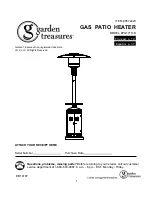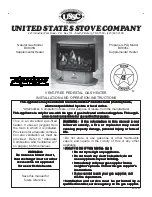
48
48
Se
rv
ic
e
J.11
Flame Signal
NOTE:
Flame signal strengths:
GOOD - 3.0 or greater, fluctuating less than 0.5 micro
amps DC
WEAK – between 0.8 and 2.9 micro amps and / or
fluctuating more than 0.5 micro amps DC
INSUFFICIENT – below 0.7 micro amps DC
1.
The flame signal strength can be monitored using
a voltmeter set to measure 0 - 10 micro amps DC, or
using the Honeywell W136 test meter.
2.
When using an ammeter, disconnect the flame rod
wire and connect the red (+) lead to the DSI flame
signal terminal, S1, and the black (-) into the flame rod
wire.
3.
Amperage is 0.0 with no flame, and a maximum of
10.0 with flame.
4.
Signals between 1.5 to 2.9 micro amps and / or
fluctuating more than 0.5 micro amps are weak. They
allow the heater to continue to operate, however
investigation and probable maintenance of flame
rod, wiring, manifold pressure and burner is required.
Expect irregular nuisance shutdowns.
5.
Flame signals dropping below 1.5 micro amps cause
the DSI to extinguish the burner and indicate alarm.
DSI LED will flash 3 times every 3 seconds.
6.
Inspection and probable maintenance of flame rod,
wiring, manifold pressure and burner is required.
J.12 Air Switch
1.
To check the air switch operation, while operating
the unit, block 80% of the air intake screens
openings with a sheet of cardboard. The heater
continues to operate.
2.
Now block 90%. The DSI extinguishes the burner and
indicates alarm with the “FSR ALARM” LED lit.
3.
Remove the blockage and reset the controller. The
heater starts.
J.13 Air Switch Calibration
1.
With the heater operating, remove the red dust
cover cap on the air switch set screw, and turn the
set screw counter clockwise to lower the set point.
Block 90% of the air intake with cardboard.
2.
Raise the set point by turning the screw clockwise
until the switch opens and causes the DSI to
extinguish the burner.
3.
Remove blockage and reset controller.
J.14 High Temperature Limit
NOTE:
The heater can not under normal circumstances raise
the air temperature to the point of closing the high limit
thermostat.
The thermostat and teh circuit can be individually
tested as follows:
1.
Turn the mode selector switch “OFF”.
2.
Open the thermostat box located on the sensor duct.
Disconnect the red and white leads of the high limit
thermostat.
3.
At temperatures below 210
°C (410°F) the high limit
thermostat contact is open. Use a multimeter to
measure continuity. Replace it if it is closed.
4.
To verify the circuit and controller operation, simulate
a high limit by shorting the red and white wires that
connect to the panel. The controller indicates alarm
with STATUS LED red, FSR ALARM LED red, ALARM
LED red and HIGH LIM LED alternating.
5.
Reconnect the thermostat and reset the controller.
6.
Return the mode selector switch to desired mode.
Summary of Contents for HELLFIRE 400
Page 26: ...26 26 Installation Figure 2 140 Clearance Figure 3 155 Clearance...
Page 27: ...27 27 Installation Figure 4 Clearance Turned 90 Degrees...
Page 39: ...39 39 THERMON HEATING SYSTEMS INC Heater Specifications...
Page 40: ...40 40 THERMON HEATING SYSTEMS INC Heater Specifications...
Page 41: ...41 41 CCI THERMAL TECHNOLOGIES INC Heater Specifications...
Page 42: ...42 42 THERMON HEATING SYSTEMS INC Heater Specifications...
Page 54: ...54 54 NOTES...
Page 55: ...55 55 NOTES...









































